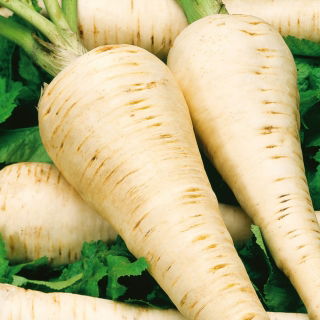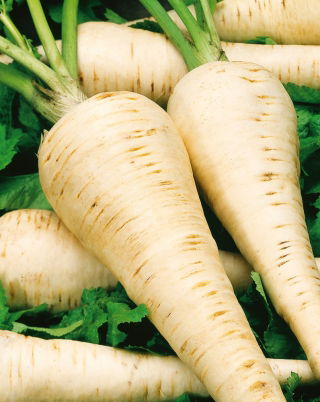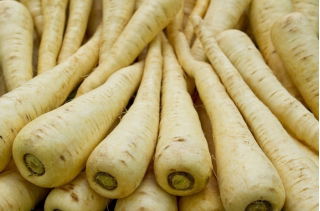The Parsnip 'Halflong White' is an exceptional variety, prized for its aromatic white flesh and mildly sweet flavour. This versatile root vegetable is a staple in many kitchens, ideal for both raw and cooked dishes. It enhances salads, soups, and purees and transforms into a delicious addition to roasted or stewed meals. Its growing popularity among healthy eaters and its adaptability in various recipes make it a must-have for any garden. By choosing premium 'Halflong White' Parsnip seeds, you ensure high-quality crops that will delight every home chef.
Sowing
The 'Halflong White' Parsnip requires careful sowing to achieve its full potential. Seeds should be sown in well-prepared soil with a fine tilth to ensure optimal growing conditions. Distribute the seeds evenly across the soil to encourage uniform development.
Sowing Depth
Sow the seeds at a depth of approximately 2 cm. This depth ensures the seeds have access to sufficient moisture and warmth, essential for germination. Cover the seeds gently with soil to protect them from adverse weather and pests.
Direct Sowing Period
The best time for sowing Parsnip seeds directly into the ground is from April to May. These months provide the ideal soil temperature and moisture levels for germination. Avoid sowing too early, as cold soil can delay plant growth and development.
Plant Spacing
Maintain a spacing of 25-40 cm between rows and approximately 5 cm between plants within a row. This arrangement ensures the plants have enough room for root expansion, access to light, and reduced competition for nutrients.
Site Conditions
Parsnips thrive in sunny, well-drained locations with fertile soil that is slightly acidic to neutral in pH. Avoid heavy or waterlogged soils, as these can lead to root rot. Incorporating organic matter such as compost will improve soil fertility and drainage, supporting healthy root development.
Growing Tips
Parsnip cultivation requires consistent care. Regular watering is essential, particularly during dry spells, to maintain soil moisture levels. Remove weeds to minimise competition for nutrients and aerate the soil to promote robust root growth. These practices ensure healthy, uniform crops.
Harvest Period
Parsnips can be harvested in two main periods: October to November and March to April. Use appropriate tools to carefully lift the roots from the soil, avoiding damage. Properly stored parsnips can be enjoyed throughout the winter, retaining their flavour and nutritional value.
Usage
The 'Halflong White' Parsnip is renowned for its culinary versatility. Its delicate flavour enhances a variety of dishes, including salads, soups, and creamy purees. Roasting or stewing this root brings out its natural sweetness, pairing perfectly with meat, fish, or vegetarian dishes.
Resistance to Diseases
Parsnips demonstrate excellent resistance to many common diseases, making them a reliable crop even for novice gardeners. Regular monitoring and the use of natural protection methods, such as crop rotation and companion planting, help prevent potential issues.
Good to Know
Parsnip has been a valued ingredient in kitchens worldwide for centuries. Its roots are rich in essential nutrients, including potassium, vitamin C, and dietary fibre, which support heart and digestive health. Additionally, its natural sweetness makes it a popular choice for low-sugar diets, often used as a healthier alternative to artificial sweeteners in cooking and baking.
Why Buy from Garden Seeds Market?
Garden Seeds Market offers top-quality Parsnip 'Halflong White' seeds, meticulously tested in laboratories to guarantee high germination rates and varietal purity. Our commitment to quality is reflected in the positive reviews from satisfied customers. With fast order processing and secure delivery, your seeds will arrive in excellent condition, ready for planting. Trust Garden Seeds Market for premium seeds that meet all your gardening needs.
The package contains 100 g of seeds. The packaging includes detailed cultivation guidelines and the sowing expiry date, ensuring successful growth and abundant harvests.








